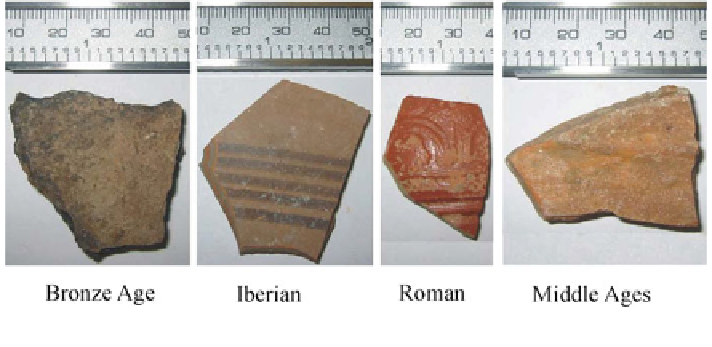Information Technology Reference
In-Depth Information
Fig. 6.2
Images of typical ceramic pieces
Feature number 5 was f
c
ð
t
0
Þ
, the instantaneous value of the centroid frequency
at a specific time instant. The parameters A
;
b
;
P
;
HOM and TR that are defined
in
Sect. 6.1.2,
were also included in the feature vector. Finally, the velocity of
propagation v of the ultrasound, which was measured by dividing the piece
thickness by the pulse arrival delay, was also considered, since it is a standard
variable in the ultrasonic characterization of materials. Figure
6.4
shows examples
of the time record, spectrum and histogram for each period. It also shows the
eleven features obtained for each example. Note the significant differences (in
general) among the feature values corresponding to different periods, which pro-
vide the opportunity for good classification performance.
First, the signal features were pre-processed with PCA 0 to reduce the
dimension of the problem as much as possible and to detect redundancies among
the selected features. This resulted in only six significant features (components),
which
were
linear
combinations
of
the
original
ones.
These
6
components
explained a total of 90 % of the data variance.
We had a total of 480*0.75 = 360 original samples for training. By adding
spherical Gaussian noise to the original samples, three replicates were estimated to
obtain a total of 1,440 samples for training. We performed 100 runs varying the
sets of 360 samples used for training and 120 used for testing. The percentage of
success
in
determining
the
correct
class
was
then
evaluated
for
a
total
of
120 9 100 testing samples.
Different alternative ICAMM-based classifiers were implemented together with
other typical classifiers. We considered four embedded ICA algorithms: non-
parametric ICA (Mixca) [
11
]; JADE (Mixca-JADE) [
12
]; TDSEP (Mixca-TDSEP)
[
13
]; and FastIca (Mixca-FastIca) [
14
,
15
]. Several PSS ratios were also tested
(PSS ratio is defined as the proportion between probabilistically labelled and
unlabelled data in the training stage). Linear Discriminant Analysis (LDA) clas-
sifier 0 was also verified as it is representative of a supervised classifier optimum
under Gaussianity assumptions. Some other classifiers based on neural networks
schemes were also implemented: radial basis function (RBF), learning vector

Search WWH ::

Custom Search